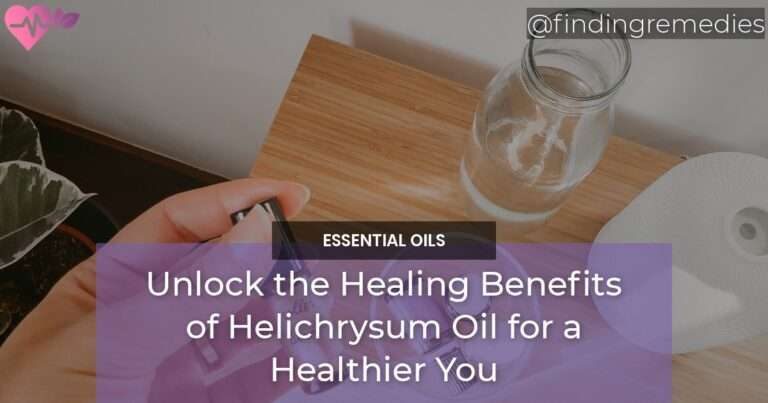Helichrysum oil is quickly gaining popularity among health enthusiasts and aromatherapy practitioners worldwide. This essential oil is known for its powerful anti-inflammatory, analgesic, and antioxidant properties, making it one of the most versatile natural remedies for a wide range of health issues. In this article, we will explore the properties and uses of helichrysum oil, its benefits for physical and emotional health, safety considerations, how to use it, and recommended dosages.
Table of Contents
What is Helichrysum Oil?
Helichrysum oil is a natural essential oil extracted from the flowers of the Helichrysum italicum plant, also known as the curry plant. This plant is native to the Mediterranean region and is now cultivated in other parts of the world, including Europe, North America, and Australia.
Extraction Process of Helichrysum Oil
The extraction process of helichrysum oil involves steam distillation of the flowers of the plant. The flowers are collected at their peak and immediately subjected to steam distillation, which separates the oil from the water. The resulting oil is then cooled and filtered, producing a pure and concentrated essential oil.
Chemical Composition of Helichrysum Oil
Helichrysum oil is a complex mixture of various chemical compounds, including terpenes, esters, sesquiterpenes, and ketones. Some of the major compounds found in helichrysum oil include alpha-pinene, beta-pinene, neryl acetate, gamma-curcumene, and italidione. These compounds are responsible for the oil’s therapeutic properties and benefits.
Benefits of Helichrysum Oil
Physical Benefits
- Reduces inflammation and pain: Helichrysum oil is a potent anti-inflammatory and analgesic agent, making it effective in reducing pain and inflammation associated with conditions such as arthritis, muscle tension, and joint pain.
- Promotes skin rejuvenation and wound healing: Helichrysum oil has skin healing properties that help to repair damaged skin and promote cell regeneration, making it an ideal remedy for acne, scars, and other skin conditions.
- Improves respiratory health: Helichrysum oil has expectorant and decongestant properties, making it effective in treating respiratory conditions such as asthma, bronchitis, and sinusitis.
- Boosts the immune system: Helichrysum oil has potent antioxidant properties that help to strengthen the immune system and protect the body against infections and diseases.
Emotional and Psychological Benefits
- Provides emotional support: Helichrysum oil has calming and soothing effects on the mind and body, making it effective in reducing stress, anxiety, and depression.
- Relieves muscle tension: Helichrysum oil has muscle relaxant properties, making it useful in reducing muscle tension and stiffness.
- Enhances mental clarity: Helichrysum oil has a refreshing and stimulating aroma that helps to enhance mental clarity, focus, and concentration.
Uses of Helichrysum Oil
Topical Use
Helichrysum oil can be applied topically to the skin after dilution with a carrier oil. It is commonly used for skin rejuvenation, wound healing, and pain relief. It can also be massaged into the muscles and joints to reduce pain and inflammation.
Aromatic Use
Helichrysum oil can be used aromatically by adding a few drops to a diffuser or inhaling directly from the bottle. Aromatic use of helichrysum oil is effective in providing emotional support, reducing stress, and enhancing mental clarity.
Internal Use
Helichrysum oil can be used internally by adding a few drops to a glass of water or in recipes. Internal use of helichrysum oil is effective in boosting the immune system and promoting respiratory health. However, it is essential to consult a healthcare provider before using helichrysum oil internally.
Safety Considerations when Using Helichrysum Oil
Helichrysum oil is generally safe for topical and aromatherapy use, but it is essential to dilute it with a carrier oil before applying it to the skin. It should not be used undiluted or applied to sensitive areas such as the eyes or mucous membranes. Pregnant and nursing women should avoid using helichrysum oil without consulting a healthcare provider.
Risks Associated with Helichrysum Oil Use
Helichrysum oil is generally safe when used as directed, but some people may experience allergic reactions, skin irritation, or other adverse effects. It is essential to perform a patch test before using helichrysum oil on the skin and to discontinue use if any adverse reactions occur.
How to Use Helichrysum Oil
Blending Helichrysum Oil with Other Essential Oils
Helichrysum oil blends well with other essential oils such as lavender, frankincense, peppermint, and eucalyptus. These blends can be used topically or aromatically to enhance their therapeutic effects.
Recommended Dosages
The recommended dosage of helichrysum oil depends on the intended use and mode of administration. As a general rule, it is recommended to use 1-2 drops of helichrysum oil per 1 teaspoon of carrier oil for topical use and 3-4 drops in a diffuser for aromatic use. Consult a healthcare provider before using helichrysum oil internally.
Recipes for Using Helichrysum Oil
- For skin rejuvenation: Mix 1-2 drops of helichrysum oil with 1 teaspoon of coconut oil and massage into the face and neck.
- For wound healing: Mix 1-2 drops of helichrysum oil with 1 teaspoon of jojoba oil and apply to the affected area.
- For respiratory health: Add 3-4 drops of helichrysum oil to a diffuser and inhale for 15-30 minutes.
In conclusion, Helichrysum oil is a powerful and versatile essential oil that offers a wide range of physical and emotional health benefits. Whether used topically, aromatically, or internally, this natural remedy provides a safe and effective alternative to conventional treatments. By incorporating helichrysum oil into your daily routine, you can unlock its healing benefits and achieve a healthier you.

